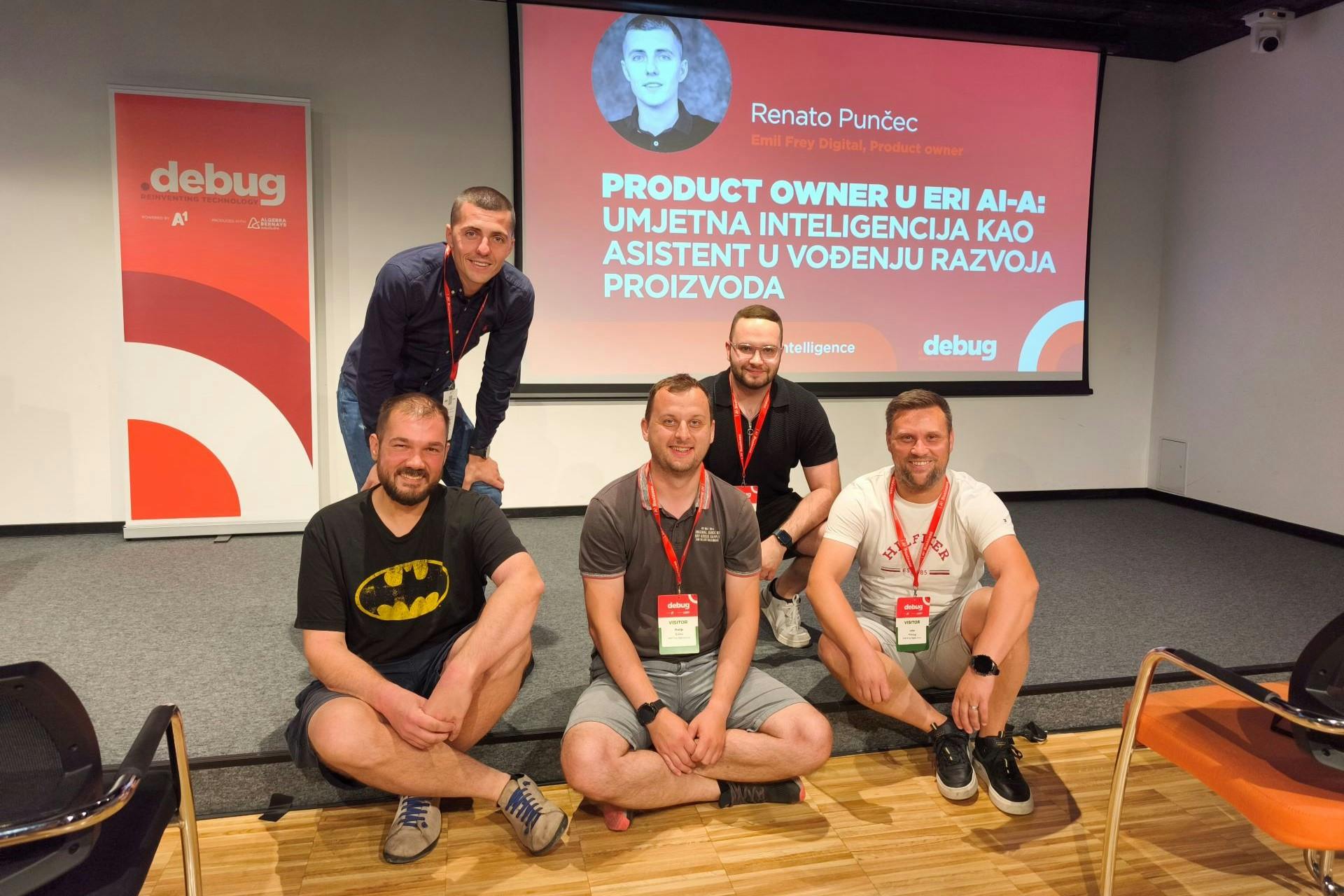16 June 2025
Product ownership in an AI age

When you are invited to one of the country’s top tech conferences for the second year in a row, it's an invitation you don’t want to refuse. It means you did something right the first time.
After a great session last year, our Product Owner Renato Punčec was invited back to this year’s edition of .debug to continue the conversation on product ownership. This time, he took the stage to speak about AI-powered Product Ownership: How AI supports product development management.
Punčec explained how AI tools can help product owners (POs) make better decisions, manage backlogs more efficiently and improve user experience. He also shared what AI tools he uses, and how to ensure that AI complements (not replaces) decision-making and strategic thinking in product ownership.
AI as an assistant in PO’s work and product development
You can learn a lot, douring the two-day conference, about how AI is helping developers, but what about product owners? How can AI tools actually help POs in their work?
Probably one of the first and most common uses of AI tools like ChatGPT was for generating user stories, acceptance criteria, and test scenarios. AI can also help with analyzing user feedback. Whether it's from surveys, web reviews, or feedback within the product (app). It helps analyze and group this data, making it easier for you to prioritize tasks in the backlog.
When product development follows industry standards, AI can suggest what you should develop next, based on your current backlog. At the same time, it helps a PO to prioritize next steps in development faster.
Another helpful application of AI in PO’s work is automating repetitive tasks, such as creating reports, processing customer requests, writing feature documentation, release notes, etc. While AI can definitely make things easier and faster, it is important to remember that the PO still needs to review and refine every AI-generated output.
For example, AI can generate an initial version of release notes based on completed user stories (implemented features). The PO needs to review and adapt this content in a way that it is clear and relevant for all stakeholders. This is especially useful as POs sometimes use technical language, while stakeholders need to clearly understand the business value of new features.
A PO also often receives new feature requests along with Excel tables with huge volumes of unstructured data. Reviewing this data manually would be difficult and time-consuming.
In this scenario, AI can quickly extract patterns or edge cases that might be important for development.
Thanks to AI, the PO has more time and bandwidth to focus on what truly matters: communication with the development team, stakeholders, and product development planning.
Practical examples of using AI in daily work
Writing user stories
POs who work on products with a large number of end users constantly receive numerous unplanned user requests. Writing user stories can sometimes take hours, or even days, and often requires brainstorming and much back-and-forth discussion, making it hard to keep their focus on planning and other key tasks. To write user stories that keep coming in, POs can use AI tools to quickly generate an initial version of a user story based on user input. The story is then saved in the backlog, waiting for its final refinement.
Over time, every PO develops a unique way of writing and structuring stories that his team understands. Therefore, it is essential that any AI-generated user story is further refined and adapted to align with the team's workflow and communication style. Also, AI can be very helpful in describing generic features that are industry standards or edge cases.
Generating meeting minutes
Meetings are an integral part of PO’s work. Especially those long planning sessions with many people involved. Thanks to AI tools, there is no longer a need for someone to take manual notes on Confluence or elsewhere. Tools like MS Teams offer transcription and an option to save it as a file that can be easily downloaded. Then, with AI tools, you can create a summary, define action points, and highlight any open questions. This allows the PO and the team to focus on the meeting, not on taking notes.
Creating leads from customer enquiries
In our car sales software, we are automating the process of converting customer enquiries received through the website into leads in the CRM system. We receive those enquiries as an email. Initially, we parsed specific fields from an email template. However, any change in the 3rd party system would break the automation, preventing our system from capturing new customer queries. Each time, we had to create, test, and deploy a new template. This became a recurring thing - month after month, year after year.
To solve this, we start using Azure Open AI solution to scrape data from emails automatically, using a prompt we create, regardless of the template. If a template changes slightly, the AI mostly understands where the change occurred. If a template is completely changed, we simply update the prompt. No code changes, no hotfixes, no new versioning.
This made our system more scalable and robust. It also gave our clients more trust in the solution - no incidents, no sprint disruptions, no urgent fixes. AI made a real impact on development, and it directly benefited the PO role.
Why AI (still) cannot replace PO
Despite all the benefits, AI still cannot replace many of the human characteristics that the PO brings to their work. First of all, AI does not have empathy or the ability to deeply understand user needs, something a PO often learns through personal communication. Likewise, AI still cannot replace a PO in strategic decision-making, defining long-term product vision, or creative thinking. AI does not understand the broader context around the product, market specifics, and strategic goals in the way that an experienced PO can.
The majority of PO decisions are not black and white, they are based on understanding the business context, project history, and relationships with stakeholders. While AI can support decision-making, it can not take responsibility for decisions instead of the PO. Prioritization in uncertain conditions often comes down to experience and a gut feeling, things AI tools do not have.
AI can support many (if not all) aspects of a PO’s work, but a PO must always check and adapt any AI output before sharing it with the team. Since AI in product ownership is still relatively new for POs, and things are evolving quickly, having the right attitude toward AI is key. Those who keep up learning, experimenting, and evaluating which AI tools actually help will see the greatest efficiency gains.
- In my opinion, the .debug conference is one of the top gatherings of the IT community in the country. A place where tech experts, including CEOs from the most successful IT companies in Croatia and the region, come together to discuss the most relevant industry topics. It is organized at a very high level, and I definitely encourage everyone to start planning their visit for next year, said Punčec.
